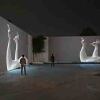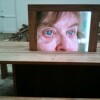Doug Aitken: Things Fall Apart
The smell: that's what you notice first in Doug Aitken's current project at Regen Projects Gallery in West Hollywood. Titled House, Aitken's installation includes a video screened on back-to-back monitors built into the center of a table and piles of crumbling drywall, old, splintered wood and gravel dispersed around the edges of the large gallery space. You can feel the dust in the air, making the sense of decay and collapse depicted onscreen all the more visceral. The short video returns to a theme in Aitken's work as it shows the destruction of a house, which is ripped apart by unseen forces while an elderly man and woman sit motionless on either side of the table.

Aitken's Blow Debris from 2000 charted a similar path, but played with the temporal unfolding of the event.

In this case, the project is entirely spatial, and depends on the installation itself, in which the space between the man and the woman in the video has been replaced by the two screens; what we witness in the gallery, then, is both the rendering of the past as it appears onscreen, and the evidence of the event in the detritus surrounding the table.
The gallery space, too, with its white walls and high ceiling, references the house, and all of this doubling backwards produces a kind of vertigo.
Engaging in what film theorist Kate Mondloch in her book Screens refers to as an "activated space," House invites viewers to consider notions of catastrophe and mediation, embodied experience next to a dematerialized event. And to take in the dusty reality of destruction.
The piece is on view through December 18, 2010.






